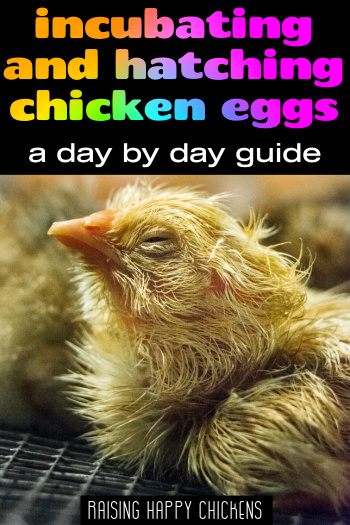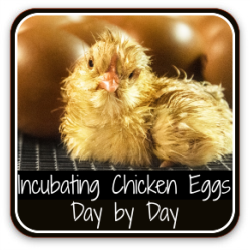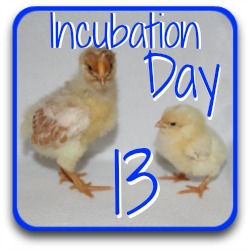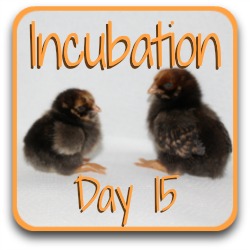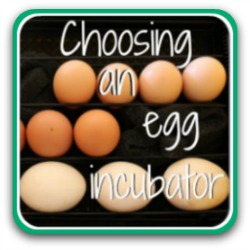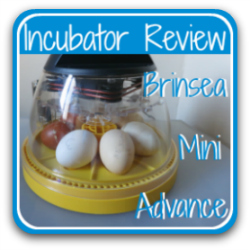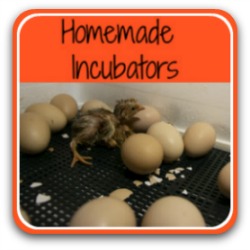- Home
- Incubation day by day
- Day 14
Hatching eggs in an incubator: day 14.
It’s getting crowded in the egg! What happens, what to do and what can go wrong at day 14 of incubation.
The end of week 2 in the chicken egg incubator, and just one more week left until hatch day.
The embryo is now a recognisable chick with distinct features. The head, body and limbs are all formed and just need to grow to full chick size over the next week.
We're able to see less and less in the candled egg now, since the chick is filling most of the space. But there are still critical things to look for and to do, to make sure our chick will continue to develop successfully.

Hatching eggs in an incubator: what's happening at day 14?
- We're two thirds of the way through incubation and the chick's skeletal growth is almost complete.
- The bones need the next few days to harden off, ready for hatching.
- If we opened the egg today, we'd see that the chick remains lying on top of the yolk, but the yolk now begins to be subsumed into its body.
- By the time hatch arrives, the whole of the yolk should have been absorbed.
- The chick moves to turn its head into the blunt end of the shell, to be near the air cell where it will eventually hatch.
- Its body, which until today has been curled into a 'C' shape, is now lying lengthways down the egg.
What's happening to the chick at day 14 in the incubator?
Please note: the image below is a commissioned piece and is subject to international copyright laws. I am the sole copyright owner.
It must not be used, copied or reproduced anywhere without my permission.
Contact me for details and permissions for this and all other images on this page.
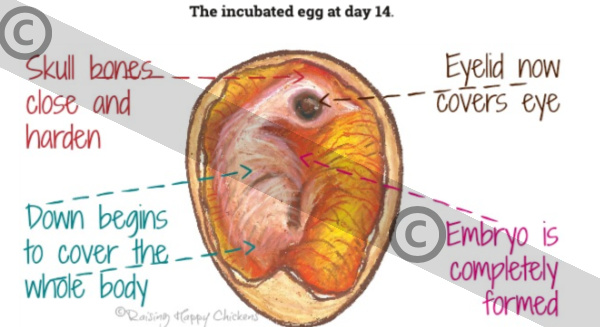
- The eye is now covered completely by the eyelids, which have been growing slowly over the last several days.
- The skull is closed and starting to harden, again relying on the chorioallantoic membrane to bring it calcium taken from the shell which in turn makes the shell more porous.
- The beak and claws are now more defined, and the egg tooth, which the chick will use to hammer its way out of the egg (known as "pipping") is formed.
- On the body, down is now growing everywhere. Within the next seven days it will cover the chick completely, ready for hatch.
What can we see if we candle the egg at day 14?
Make sure when candling incubated chicken eggs that you observe strict hygiene processes. Eggs become porous during incubation, and bacteria are easily transmitted through the shell.
- Use a good quality, medicated hand sanitiser. (This is an affiliate link which means that if you click the link and buy a product, I earn a small commission).
- Ensure all surfaces, including the candler, are kept spotlessly clean.
If you're candling from this point on it's unlikely you'll see much movement. The chick is filling a large part of the egg, so it's getting crowded in there. There's not much room to move about.
The most movement now is as the chick positions itself correctly for hatch with its head at the blunt end of the egg, near the air cell.
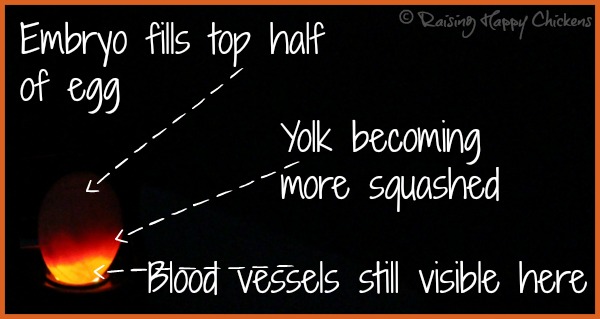
Below is the same photo with the shadows enhanced. It doesn't show much difference. The blood vessels are slightly clearer but apart from that, there's not much to see at day 14.
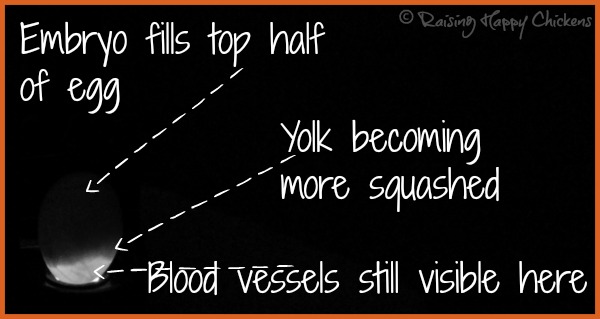
What should we be doing at day 14?
Today is a good time to candle any eggs you weren't sure about earlier in the incubation process.
If an egg hasn't developed by now, it's not going to.
Any eggs which show no signs of development, or where the embryo has died, should be taken out of the incubator at this point and discarded. It always feels hard, but leaving them runs the risk of their going bad and leaking bacteria over the other eggs.
An egg which is showing no signs of development will look like the one below.
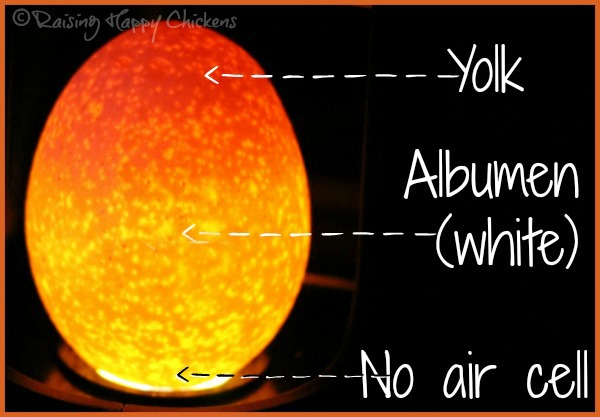
Can anything go wrong at this stage?
At this stage in the process the eggs are very porous as the chick requires more and more calcium from the shell to harden its skeleton.
The shell can therefore take in and give out bacteria very easily, so here's another reminder to wash your hands before and after handling incubated eggs!
Not doing so means you'll potentially transmit bacteria and compromise your hatch, or carry bacteria away from the incubator and make yourself ill.
Question of the day.
What is a "blood ring" in the chicken egg?
A blood ring in an incubated chicken egg is a sign that an embryo has started to develop, but died at some point during incubation – usually quite early in the process.
When that happens, the blood vessels which were growing to sustain the embryo stop developing and 'pool' in the egg. When candled, you'll be able to see them as a dark ring around the circumference.
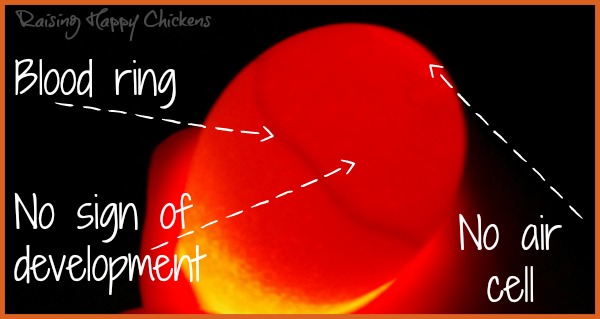
In the photo above, there is no indication of any embryo or air cell and the blood ring is very clear. This embryo has stopped developing at around day 3 or 4 and should be discarded.
See more detail about blood rings in the chicken egg and what happens if they are not discarded.
Where to next?
If you'd like to start at the beginning of this day-by-day course describing hatching eggs in an incubator, click the first button link. For yesterday's information use the day 13 button and to progress to tomorrow, it's day 15.
Hatching eggs in an incubator: related pages.
Sources.
A lot of "facts" you'll find on the internet are often people's individual views, based on inaccurate information repeated from poor quality sources.
The information I provide in this article and others is based on both my own experience of incubating and hatching chicken eggs every year for over 13 years, but on evidenced facts from scientific, peer-reviewed research and books from highly respected and experienced poultry keepers such as Gail Damerow.
Some of the trusted sources I have used in this article are these.
Avitronics: Heart Rates. Pub. Avian ID, 2020.
Damerow, Gail: Hatching and Brooding Your Own Chicks. Pub. Storey, 2013. See my review, here.
Hall, C., et al: A new candling procedure for thick and opaque eggs and its application to avian conservation management. Pub. Journal of Zoobiology, 2022.
Hamburger, V and Hamilton, H L: A series of normal stages in the development of the chick embryo. Pub. Journal of Morphology, 1951.
Leonor, H., and Chaveiro, S: The Effect of Candling on the Hatchability of Eggs from Broiler Breeder Hens. Pub. Journal of Applied Poultry Research, 1993.
Phuphanin, A., et al: Smartphone-Based Device for Non-Invasive Heart-Rate Measurement of Chicken Embryos. Pub. National Center for Biotechnology Information, 2019.
Vargas, R., et al: Egg Candling Analysis Equipment Design: A Safety Solution. Pub. Journal of Social and Behavioural Sciences, 2018.
Wu et al: Egg fertility and reduced egg fertility, hatching success, and larval survival. Pub. Science Direct, 2003.
- Home
- Incubation day by day
- Day 14
